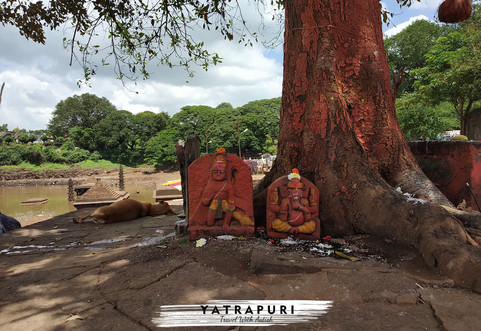Panchaganga Ghat the oldest civilization of Kolhapur, guarded by Shiva temple.
- Aatish Chavan

- Apr 3, 2020
- 3 min read
The Panchganga River flows through the borders of Kolhapur. It starts from Prayag Sangam (Village: Chikhli, Taluka: Karr, Dist:Kolhapur). The Panchganga is formed, as has been noted already, by four streams, the Kasari, the Kumbhi, the Tulsi and the Bhogawati. Local tradition believes in an underground stream Saraswati which together with the other four streams make the Panchganga.
The Prayag Sangam confluence marks the beginning of the Panchganga river proper which after receiving the waters of the four tributaries continues in a larger pattern with the flow of waters received from the rivers. From North of Kolhapur it has a wide alluvial plain. After developing this plain the river resumes its course eastwards.
The Panchganga River is a lifeline of Kolhapur people. It starts from Prayag Sangam (Village: Chikhali, Taluka: Karveer, Dist:Kolhapur). The Panchganga is formed, as has been noted already, by four streams, the river Kasari, the Kumbhi, the Tulsi and the Bhogawati. Local tradition believes in an underground stream Saraswati which together with the other four streams make the Panchganga.
The Prayag Sangam confluence marks the beginning of the Panchganga River proper which after receiving the waters of the four tributaries continues in a larger pattern with the flow of waters received from the rivers. From North of Kolhapur it has a wide alluvial plain. After developing this plain the river resumes its course eastwards.
From Kolhapur, the Panchganga River, as the river is now called, winds east about thirty miles till it falls into the Krishna at Kurundvad. In the thirty miles of its course, to the east of Kolhapur the Panchganga River receives only one considerable stream the Hatkalangale or Kabnur which, rising from the Alate hills and passing Hatkalangale and Korochi joins the Panchganga near Kabnur about fifteen miles below Kolhapur.
From Shiroli to its junction with the Krishna near Shree Kshetra Nrusinhawadi (Narsobawadi), it has an extensive alluvia floor bordered by the large worn out stumps of the Alate portion of the Panhala in the north and the Hupari part of the Kasaba Sangaon range in the south. A characteristic feature of this basin is the contrast between the rounded worn out features locally known as Mals and the general entrenched nature of all the streams.
A further noteworthy aspect is the deeply incised course of the Panchganga itself. From Mangaon, the river flows in a deep bed that is well below 40 feet from the surrounding plain. Further downstream it develops an incised meander-core which includes the Narsobawadi area.
The valley of the Panchganga is reckoned the most fertile in Kolhapur and is famous for its hay. The bed of the river is shallow and its sloping banks yield rich crops during the cold weather. At Kolhapur, the Panchganga is crossed by two beautiful bridges one near the Brahmapuri hill on the north side of Kolhapur town on the road leading to the Amba pass, and the other a few miles to the east on the Poona road. The Panchgnaga and its feeders are fordable in the hot season. In the rainy season large and small boats ply at twenty-three fords.
The waters of all the streams which join to form the Panchganga are much used for growing sugarcane. In October, towards the close of the south-west rains, a series of fair-weather earthen dams are built across the river beds and the water is raised by lifts worked by bullocks,
Panchaganga Ghat:
To the north-west of the city, there is an extensive ghat on the Panchaganga River. There are numerous temples here including some in the river itself. The ghat consists of long stone flights of steps reaching down to the river and is used for bathing and washing. One gets a very picturesque view from the ghat. To the north overlook this bridge, the ghat and the river is in Brahampuri Hill, the site of the ancient city.
Panchaganga Ghat is one of the oldest spots in Kolhapur. The civilization of Kolhapur began on the banks of River Panchganga. The bank on West end of City is known as Panchganga Ghat. There is an ancient Temple on the Banks and a small Jetty (for washing clothes etc. during old days.) The beautiful scenic look at the River from Jetty though SHIVAJI BRIDGE is worth a snap at anytime. A Small picnic spot is developed near the bridge, giving a good view at the Ghat and the temple.
Every year a Fair is organized here and attracts thousands of tourist from all over Maharashtra and India. Local Authorities have plans to develop this location further for immersion of Ganpati Idols during Ganesh Festival
















































Comments